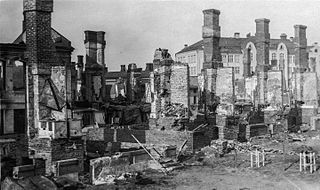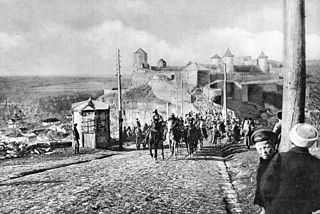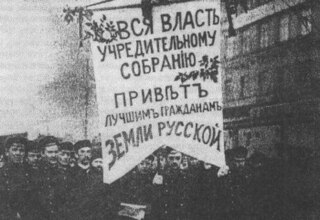Related Research Articles

The Finnish Civil War was a civil war in Finland in 1918 fought for the leadership and control of the country between White Finland and the Finnish Socialist Workers' Republic during the country's transition from a Grand Duchy of the Russian Empire to an independent state. The clashes took place in the context of the national, political, and social turmoil caused by World War I in Europe. The war was fought between the Reds, led by a section of the Social Democratic Party, and the Whites, conducted by the conservative-based Senate and the German Imperial Army. The paramilitary Red Guards, which were composed of industrial and agrarian workers, controlled the cities and industrial centers of southern Finland. The paramilitary White Guards, which consisted of land owners and those in the middle and upper-classes, controlled rural central and northern Finland, and were led by General C. G. E. Mannerheim.
The Treaty of Brest-Litovsk was a separate peace treaty signed on March 3, 1918, between the new Bolshevik government of Russia and the Central Powers, that ended Russia's participation in World War I. The treaty was signed at German-controlled Brest-Litovsk, after two months of negotiations. The treaty was agreed upon by the Russians to stop further invasion. As a result of the treaty, Soviet Russia defaulted on all of Imperial Russia's commitments to the Allies and eleven nations became independent in eastern Europe and western Asia.

The Treaty of Paris of 1856 brought an end to the Crimean War between the Russian Empire and an alliance of the Ottoman Empire, Great Britain, the Second French Empire and the Kingdom of Sardinia.

The Senate of Finland combined the functions of cabinet and supreme court in the Grand Duchy of Finland from 1816 to 1917 and in the independent Finland from 1917 to 1918.

The Transcaucasian Democratic Federative Republic was a short-lived state in the Caucasus that included most of the territory of the present-day Armenia, Azerbaijan and Georgia, as well as parts of Russia and Turkey. The state lasted only for a month before Georgia declared independence, followed shortly after by Armenia and Azerbaijan.

The Treaty of Bucharest (1918) was a peace treaty between Romania and the opposing Central Powers following the stalemate reached after the campaign of 1917. This left Romania isolated after Russia's unilateral exit from World War I.

Various factions fought over Ukrainian territory after the collapse of the Russian Empire following the Russian Revolution of 1917 and after the First World War ended in 1918, resulting in the collapse of Austria-Hungary, which had ruled Ukrainian Galicia. The crumbling of the empires had a great effect on the Ukrainian nationalist movement, and in a short period of four years a number of Ukrainian governments sprang up. This period was characterized by optimism and by nation-building, as well as by chaos and civil war. Matters stabilized somewhat in 1921 with the territory of modern-day Ukraine divided between Soviet Ukraine and Poland, and with small ethnic-Ukrainian regions belonging to Czechoslovakia and to Romania.
The Treaty of Poti was a provisional agreement between the German Empire and the Democratic Republic of Georgia in which the latter accepted German protection and recognition. The agreement was signed, on 28 May 28 1918, by General Otto von Lossow for Germany and by Prime Minister Noe Ramishvili and Foreign Minister Akaki Chkhenkeli for Georgia at the Georgian Black Sea port of Poti.

The German Caucasus expedition was a military expedition sent in late May 1918, by the German Empire to the formerly Russian Transcaucasia during the Caucasus Campaign of World War I. Its prime aim was to stabilize the pro-German Democratic Republic of Georgia and to secure oil supplies for Germany by preventing the Ottoman Empire from gaining access to the oil reserves near Baku on the Abşeron peninsula.

The Treaty of Brest-Litovsk was a peace treaty signed on 3 March 1918 between the Russian Soviet Federative Socialist Republic and the Central Powers. However, on 9 February 1918, the Central Powers signed an exclusive protectorate treaty with the Ukrainian People's Republic as part of the negotiations that took place in Brest-Litovsk, Grodno Governorate recognizing the sovereignty of the Ukrainian People's Republic. Although they did not formally annex the territory of the former Russian Empire, Germany and Austria-Hungary secured food-supply support in return for providing military protection. The Central Powers recognised Ukraine as a neutral state.

Occupation of Estonia by the German Empire occurred during the later stages of the First World War. On 11-21 October 1917, the Imperial German Army occupied the West Estonian archipelago, consisting of the islands of Saaremaa (Ösel), Hiiumaa (Dagö), and Muhu (Moon).

Edvard Immanuel Hjelt was a Finnish chemist, politician and a member of the Senate of Finland. Hjelt studied chemistry in Finland and in Germany and became rector of the University of Helsinki in 1899. He opposed the increasing influence of Russia in the Grand Duchy of Finland and started his career in politics. Good connections to Germany created during his chemistry studies before and after his graduation made it possible for him to get military help during the Finnish Civil War. Hjelt organized the training of the Finnish Jäger troops in Germany.

The Operation Faustschlag, also known as the Eleven Days' War, was a Central Powers offensive in World War I. It was the last major action on the Eastern Front.

The Ukrainian People's Republic (UPR), or Ukrainian National Republic (UNR), was a country in Eastern Europe that existed between 1917 and 1920. It was declared following the February Revolution in Russia. In March 1917, the National Congress in Kyiv elected the Central Council composed of socialist parties on the same principles as throughout the rest of the Russian Republic. The republic's autonomy was recognized by the Russian Provisional Government. Following the October Revolution, it proclaimed its independence from the Russian Republic on 25 January 1918.

On 15 December [O.S. 2 December] 1917, an armistice was signed between the Russian Soviet Federative Socialist Republic on the one side and the Austro-Hungarian Empire, the Kingdom of Bulgaria, the German Empire and the Ottoman Empire—the Central Powers—on the other. The armistice took effect two days later, on 17 December [O.S. 4 December]. By this agreement Russia de facto exited World War I, although fighting would briefly resume before the Treaty of Brest-Litovsk was signed on 3 March 1918, and Russia made peace.

Events from the year 1918 in Russia

The Invasion of Åland was a 1918 military campaign of World War I in Åland, Finland. The islands, still hosting Soviet Russian troops, were first invaded by Sweden in late February and then by the German Empire in early March. The conflict was also related to the Finnish Civil War including minor fighting between the Finnish Whites and the Finnish Reds.

The Azerbaijan–Turkey border is a short 17 km (11 mi) long international border between the Republic of Azerbaijan and the Republic of Turkey. The border is located at the southeastern tip of the Iğdır Province on the Turkish side and at the northwestern tip of the Nakhchivan Autonomous Republic on the Azerbaijani side; running entirely along the Aras river, it is the shortest border for both countries.
The Treaty of Peace between Austria-Hungary and Finland, also called the Vienna Peace Treaty, was signed in Vienna on 29 May 1918, bringing to an end the state of war that existed between Finland and the Austro-Hungarian Empire as a result of World War I.
Central Powers intervention in the Russian Civil War consisted of a series of multi-national military expeditions starting in 1918. This was intervention was picking up from the Eastern Front against the newly set up Russian Republic. The main goals of the intervention were to maintain the territories received in the Treaty of Brest-Litovsk, prevent a re-establishment of the Eastern Front, and administer new conquered territories. After the defeat of the Central Powers, many armies that stayed mostly helped the White movement eradicate communists in the Baltics until their eventual withdrawal and defeat. In addition, pro-German factions fought against the newly independent Baltic states until their defeat by the Baltic States, backed by the victorious Allies
References
- 1 2 3 Randall Lesaffer and Mieke van der Linden, "Peace Treaties after World War I", in Frauke Lachenmann and Rudiger Wolfrum (eds.), The Law of Armed Conflict and the Use of Force: Articles from The Max Planck Encyclopedia of Public International Law (Oxford University Press, 2017), pp. 910–919, at 911.
- 1 2 3 4 5 Stephan Verosta, "Peace Treaties after World War I", in Rudolf Bernhardt (ed.), Encyclopedia of Public International Law 4: Use of Force – War and Neutrality – Peace Treaties (N–Z) (North Holland, 1982), pp. 110–117, at 112.
- ↑ Patrick Salmon, Scandinavia and the Great Powers, 1890–1940 (Cambridge University Press, 1997), p. 246.
- 1 2 Jaakko Uotila, The Finnish Legal System (Suomen lakimiesliiton kustannus, 1966), p. 249.
- 1 2 3 J. Hampden Jackson, "German Intervention in Finland, 1918", The Slavonic and East European Review 18:52 (1939), pp. 93–101.
- ↑ Pauli Kruhse (trans.), Memorandum of Rafael Erich to the Senate (undated), found in a typewritten manuscript in the archive of Edvard Hjelt, now in the National Archives of Finland.
- 1 2 3 4 Texts of the Finland "Peace": With Map (Washington, D.C.: Government Printing Office, 1918), pp. 13–26 (German text as published in the Deutscher Reichsanzeiger on 8 March 1918 with English translation).
- ↑ Heike Niebergall-Lackner, Status and Treatment of Deserters in International Armed Conflicts (Leiden: Brill, 2016), pp. 128–29.
- ↑ Treaty of Commerce and Navigation between Finland and Germany, signed at Berlin, 7 March 1918, Oxford Historical Treaties, Oxford Public International Law.
- ↑ Additional Protocol to the Treaties of Peace and Commerce and Navigation between Finland and Germany, signed at Berlin, 7 March 1918, Oxford Historical Treaties, Oxford Public International Law.
- ↑ D. G. Kirby (ed.), Finland and Russia, 1808–1920: From Autonomy to Independence (A Selection of Documents) (Macmillan, 1975), pp. 234–237.
- ↑ Treaty of Peace and Amity between Bulgaria and Finland, signed at Berlin, 21 May 1918, Oxford Historical Treaties, Oxford Public International Law.